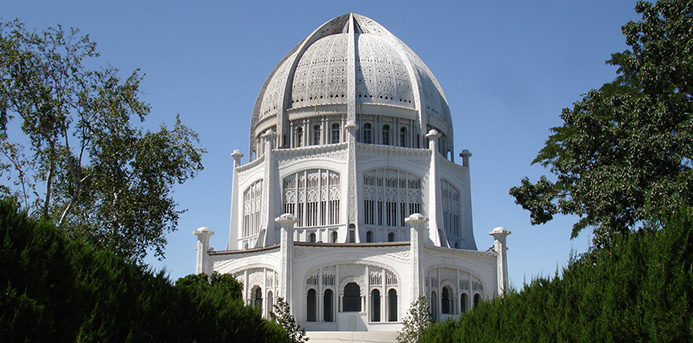If you’re looking for inspiration to explore our communities this summer—with visitors, or without—we have advice from an expert.
Blair Kamin, the Pulizer Prize-winning architecture critic for the Chicago Tribune and a Wilmette resident, gave us his personal list of North Shore gems. This isn’t an authoritative guide, but simply the places Kamin most enjoys, and that he believes represent the best of North Shore living—from Frank Lloyd Wright’s Prairie-style houses down to the roads we drive on.
Sheridan Road
“It’s our Lake Shore Drive, yet it couldn’t be more different from its shoreline sibling. The road itself is a narrow, tree-lined ribbon. If the Edens Expressway is how we really get around, Sheridan Road is how we should get around. It’s gracious and timeless, save for the unfortunate McMansions that have popped up alongside it in recent years.”
The Glencoe Train Station
“The train stations of the North Shore are civic gateways that send revealing messages about their towns. This one, with its bold turret, picturesque massing, and rough-hewn stonework, plays that role particularly well.”
The Baha’i Temple and Gillson Park, Wilmette
“I have two favorite spots along Lake Michigan and they stand side-by-side in Wilmette—one, a great, white filigreed dome; the other, a sprawling, nearly 60-acre park, which was created in the early 20th century from landfill excavated to form the North Shore Channel. It is a joy to walk through Gillson with my wife, Chicago Tribune writer Barbara Mahany. Our route takes us along the beach, with the dune grasses on one side and the ever-changing lake on the other, and then back home, guided by the temple’s extraordinary presence.”
Mahoney Farm Preserve, Kenilworth
“The ‘farm preserve’ is actually a small, serene park, bisected by Sheridan, that consists of two oval-shaped meadows lined by meandering pathways and woods. The designer, the great landscape architect Jens Jensen, outfitted the meadows with his trademark ‘council rings,’ or gathering places, made of flat, layered limestone.”
Market Square, Lake Forest
“The ritual of shopping is as essential to North Shore life as commuting or beach-going, and nowhere is that ritual given more elegant architectural expression than in this charming, Arts and Crafts-style shopping center by Howard Van Doren Shaw. From the iconic but architecturally varied clock towers to the arcaded buildings that frame the graceful public space, Market Square is a commercial center worthy of Lake Forest’s mansions—at once impressive and understated.”
The Crow Island School, Winnetka
“If one building symbolizes the North Shore’s commitment to quality education, it’s this one. Crow Island broke the mold of the school as an intimidating temple of knowledge. It substituted a child-centered model of school design, organized around village-like clusters of classrooms for different age groups, each with its own outdoor play area. Hundreds of schools around the country followed its example.”
Ward Willits House, Highland Park
“Frank Lloyd Wright’s first Prairie style house was in Oak Park, right? Wrong. Many experts regard this impressive Sheridan Road house, with its ground-hugging base and overhanging hip roofs, as the first true Prairie design. Indeed, outside of Oak Park and River Forest, the North Shore can claim one of the most impressive collections of Wright’s work, especially in Glencoe, where the Ravine Bluffs development offers Wright-designed sculptures and a bridge as well as homes.”
Daniel Burnham’s Former Estate, Evanston
“The great architect and urban planner who did so much to shape Chicago didn’t live there. Burnham moved to the suburbs for reasons that were altogether typical: He thought the city was too dirty and dangerous for his children. Yet befitting Burnham’s ‘make no little plans’ credo, his home was big—an Italianate mansion on an estate that encompassed two city blocks. Today, the mansion is gone, but traces of Burnham’s presence remain, along the street called Burnham Place and in the nearby shoreline park that also bears his name.”
Brick Streets, Wilmette
“Wilmette has 14 miles of these antiquated but wonderful roadways, more than 20 percent of its total of streets. With their mottled palette and inherent human scale—a brick is built to be the size of the human hand—they are far more lovely to behold than utilitarian asphalt.”
Photo credit: Baha’i Temple photo courtesy of Flickr Creative Commons: http://www.flickr.com/photos/spablab/

